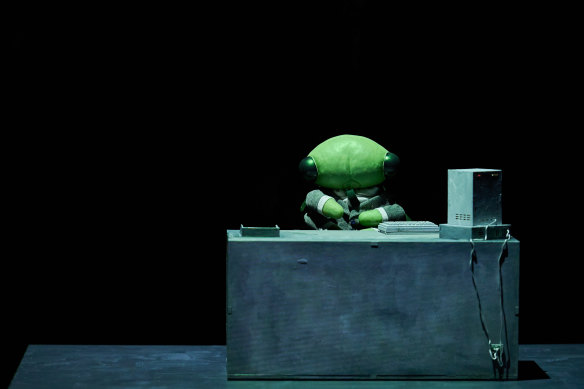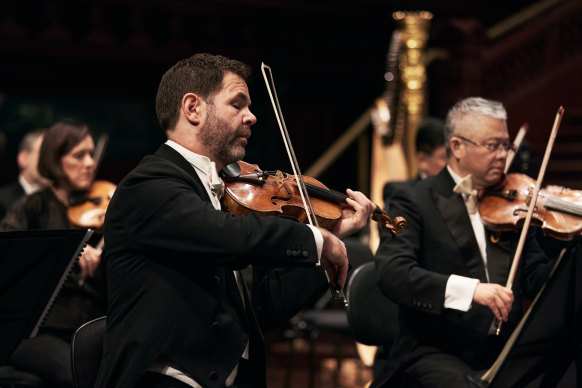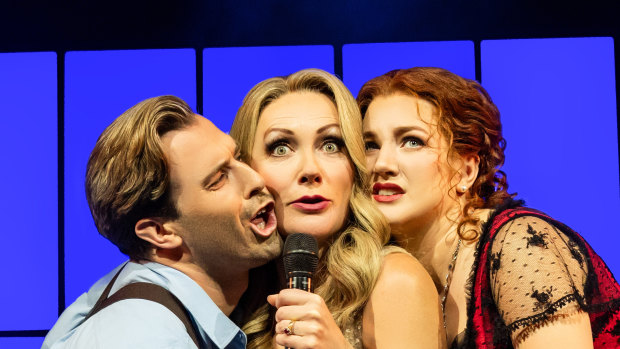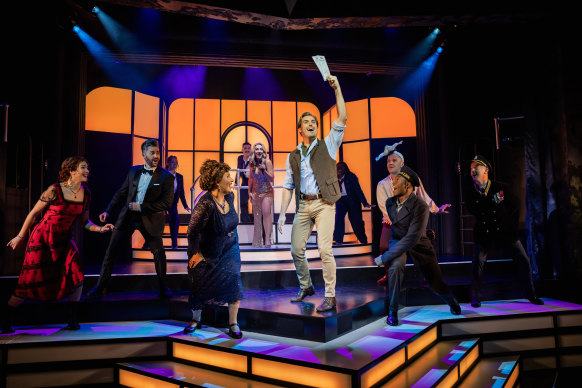This was published 4 months ago
You’ll arrive curious and leave in a state of lingering wonder and happiness
By Chantal Nguyen, Joyce Morgan, Peter McCallum, Shamim Razavi and John Shand
CICADA
Wharf 2 Theatre, September 21
Until October 13
Reviewed by JOHN SHAND
★★★★½
The magic lies in the mystery. No one – especially children – has to understand all that happens in a story to delight in it. The parts that leave you guessing can often be the best bits. So not only is your brain fully engaged by Cicada, but so is the full panoply of emotions, including that fascinating one that beauty triggers: an ephemeral mixture of wonder and sadness, which we’re made to feel time and again.
Shaun Tan’s award-winning children’s book mythologises the 17 years that some cicada species live underground in their nymph phase, before bursting forth to shed their skins, take to the air, drum up a racket, and enthusiastically mate. For the underground 17 years, Tan has his hero working at a desk job in the basement of an office building, taking no sick days and making no mistakes, but, in a human-centric workplace, he receives endless vilification and bullying rather than promotion.

Tan’s disturbing graphic world is realised with just a desk and a simple cicada puppet.Credit:
This luminous adaption was written by Barking Gecko Theatre’s Luke Kerridge (who also directs it), Arielle Gray and Tim Watts (who perform it, with Watts also responsible for the video design). They’ve taken Tan’s striking and somewhat disturbing graphic world, and realised it with just a desk, a simple cicada puppet (voiced and operated by Watts) and some headless, two-dimensional humans (voiced and operated by Gray). Ingenious use of props, video, lighting and music compound a theatrical experience that would already be enchanting were Watts just “being” his cicada.
The full scope of Tan’s story has been captured (and even expanded – perhaps just a trifle too much). Firstly, for all the many ways in which humanity abuses him, Cicada copes with a ready cheerfulness that is the flesh on the spine of his stoicism and resilience, and a catalyst for abundant humour.
More importantly, the book’s mystery is not lost. The creature’s lifecycle has parallels with reincarnation and resurrection, and Cicada’s malignant treatment by the humans could a be metaphor for all sorts of “othered” groups, but nothing is overt. With nothing explained, the play will generate that most priceless of family interactions: conversation.
You enter the theatre in a state of curiosity as to how a 28-page picture book becomes a 55-minute play, and you walk out enriched, moved, happier and in a state of lingering wonder.
Donald Runnicles Conducts Mahler’s Fourth Symphony
Sydney Symphony Orchestra
Sydney Opera House Concert Hall
September 25
Reviewed by PETER McCALLUM
★★★★
Mahler once remarked to confidante Natalie Bauer-Lechner that his Fourth Symphony was like “the uniform blue of the sky”, which remains blue even when we ourselves become terrified of it. There was certainly nothing to be terrified of in the first movement’s exposition in the Sydney Symphony’s performance under Donald Runnicles and concertmaster Andrew Haveron.
They shaped the carefully marked opening theme with scrupulous care without losing spontaneity. Mahler’s exaggerated holding back at the start of the melody came across as a fleeting indulgence of sentimentality, and the second theme, from violas and oboe, exuded longing sweetness without pain.

SSO concertmaster Andrew Haveron.Credit: Nick Bowers
The development hints at darkness. But, in the hushed return of the opening idea just before the movement closes, one could feel that the tortured Mahler was, at least for the moment, reconciled with happiness. After the sardonic second movement, with Haveron’s (deliberately) mistuned “devil’s” violin, it was in the spacious slow movement that one felt the blue sky’s anguish.
Runnicles sustained a slow tempo. Any hint of forward-moving impatience was stilled and the second idea on oboes and bassoon was mournfully lyrical. Haveron led the powerful climactic moments with force but without over-dramatisation, and it was only in the unexpected blazing eruption of full orchestra just before the close that one remembered the sun. That returned in the finale, with soprano Ying Fang joining the orchestra surreptitiously behind the strings so that her folk-like song blended with the ensemble, and receded into surrounding glow like the last gleams of twilight.
In the first half Fang presented a bracket of six early songs by Richard Strauss with a remarkable voice of polished delicacy, sweetness and strength without forcefulness. In Wiegenlied she sustained a hauntingly fragile line through a dreamscape of shimmering softness and strangeness. Haveron played the violin solo of Morgen! with silvery clarity, Fang entering as though to interrupt a reverie to find grounded warmth in the middle section.
Zeuignung was carried with resolve, strength and glowing exultance in the penultimate line. Die Nacht had penetratingly sweet high notes and Fang opened out the tone at the close of Allerseelen to fill the hall with a sound of glorious purity. In Muttertandelei she demonstrated she could be playfully overbearing and matronly when needed.
To introduce this carefully curated look at the turn of the twentieth century, Runnicles led the SSO in Anton Webern’s early work Im Sommerwind, a work drenched in Romantic sweetness before the composer discovered the austere modernity that was to be his enduring achievement.
Mozart’s Horn
Australian Haydn Ensemble
Utzon Room, Sydney Opera House
September 24
Reviewed by PETER McCALLUM
★★★½
To start, horn player Carla Blackwood demonstrated what the natural horn – the horn without valves to vary pitch – can do with full-throated ease. We heard an E-flat arpeggio of warm velvety burnish with a stepwise scale at the top.
Then she showed what could be fudged by clever manipulations of hand and lip. We heard a perfectly even chromatic scale with the previously missing pitches filled in with buzzed notes and funny voices, like an immaculately prepared comic lineup.
In a Horn Quintet in E flat major by Wilhelm Gottlieb Hauff, Blackwood played with nimble elegance and a wonderfully open sound against an accompaniment from string players of the Australian Haydn Ensemble.
A lamenting passage in minor key in the second movement highlighted the expressive potential of the buzzed notes, muting the ends of phrases with an apt dying fall. In Mozart’s Horn Quintet in E flat major, K. 407, there was a coy exchange during the transition passage between horn and first violinist and artistic director, Skye McIntosh, where the horn seems to be saying “I can do anything you can”.
Mozart’s minor key episode in the finale also perilously calls for stopped notes. Blackwood showed masterly control of both troublesome and trouble-free notes, shaping and tapering phrases with refinement.
After interval, Blackwood and the Haydn Ensemble played a Romance for horn and string quartet that uses an identical melody to that used in Mozart’s Horn Concerto No. 3, K. 447. Here, the line had gracious serenity, both in the open notes of the stately theme and subsequent more animated passages.
In the first half, the Haydn Ensemble string players excerpted the first movement from Mozart’s great masterpiece, the String Quintet in G minor, K. 516. Here, as in the arrangement for string quintet by Lichtenthal of Mozart’s Symphony No. 41, K. 551, the Jupiter, there was a tendency to segment phrases into two-bar groups that sometimes inhibited connections and development of longer reaching musical thought.
Mozart’s miraculous contrapuntal finale to the Jupiter galvanised the players to energised articulation and strong gestural statements. Chamber music arrangements of masterworks were necessity-driven in Mozart’s age. Today, with a wealth of superbly polished performances available on demand, they provide an insight into the rough and ready context in which many of Mozart’s original listeners would have experienced this music for the first time.
LA Philharmonic Wind Quintet
Utzon Room, Sydney Opera House
September 22
Reviewed by PETER McCALLUM
★★★★½
Unlike the string quartet, which usually cultivates a homogeneous tone – a “unity of four” as one 19th-century writer put it – the wind quintet, of necessity, presents a more motley sonic fabric.
Four of the five instruments produce sound in different ways (the oboe and bassoon being at least united in using a double reed), and this seems to have prompted composers to deliberately exploit the varying musical personalities these differences engender, for both comic and serious effect. And, as Shakespeare’s Jaques noted, each one, in their time, plays many parts.
Thus, in the introduction to the first movement of the Wind Quintet No. 1 by Jean Francaix, horn player Andrew Bain played the tranquil theme with every appearance of respectable decorum, only to launch into rapid repeated notes as though digging the other players in the ribs.
He and oboist Ricardo Barbosa Pereira then embarked on a scurrying exchange of scales, with the horn putting on a muted comic voice as though written to accompany animated characters dashing robotically across a computer screen. Francaix seems to have taken delight in pushing such caricatures and then suddenly putting on a serious face.
The LA Philharmonic players created a sparklingly agile musical cast, by turns cheeky, sentimental, anguished and never less than brilliant. At the start of Ross Edwards’ Incantation, each instrument enters inquisitively, like animals gathering near water at dawn, before the music evolves to lively irregularity and numbing repetitions.
Tzigane by American flautist and composer Valerie Coleman brought out the more incisive and piercing side of clarinettist Boris Allakhverdyan’s sound, the players sparking off one another virtuosically against superbly unanimous rhythmic groove.
Carl Nielsen’s Wind Quintet was written with the stated aim of bringing out the personalities of the Copenhagen Wind Quintet, whom Nielsen knew, particularly in the extended set of variations that make up the final movement.
Pereira played cor anglais for the Praeludium with darker greyish timbre and smooth surface. Flautist Denis Bouriakov had a lean agile tone for the quick variation, having earlier displayed a finely tempered yet soft-edged metallic breadth. Bassoonist Whitney Crockett played with light, refined polish and precision, also summoning peremptory sternness and heft when needed. For encore, horn player Bain revealed finely burnished warmth in Maria, that number completing selections from Bernstein’s West Side Story heard earlier in the program.
Titanique
The Grand Electric, September 22 until November 3
Reviewed by CHANTAL NGUYEN
★★★½
I didn’t even have to see Titanique the musical to start chuckling. The marketing taglines alone were hysterical: “Nothing on earth could come between Jack and Rose. Except Céline Dion.”

Marney McQueen (centre) plays Céline Dion, the diva who comes between Jack (Drew Weston) and Rose (Georgina Hopson) in the camp fever dream, Titanique.Credit: Daniel Boud
If that sounds like an excuse for a camp fever dream, you are right. Do not attend this musical if you are stressed by flashing lights, sequins and illuminated staircases. Do attend if you are a Titanic film tragic, a Céline Dion superfan, or – ideally – both.
Titanique, created by Marla Mindelle, Constantine Rousouli and Tye Blue, comes to Sydney from off-Broadway. It begins with pop superstar Céline Dion (Marney McQueen) dramatically revealing she, too, was a Titanic passenger.
The rest of the musical is her increasingly unreliable flashback. It lovingly follows the outline of James Cameron’s film Titanic – but more camp, and with Céline Dion shamelessly using every plot development to burst into song.
McQueen is hilarious as Céline Dion. The signature quirks are all affectionately parodied: the slightly nasal French-Canadian accent, the non-sequiturs, the widened eyes and surprised grimace, the fist-pumping, hand-raising, and chest-hitting (known to fans as “the Céline salute”). McQueen’s singing voice is gorgeously clear and powerful enough to pull it off.
The rest of the ensemble portrays a larger-than-life cast of characters zanily transposed from the film. There’s sweet-voiced Rose (Georgina Hopson), bullied by her rich, space gun-wielding fiancé Cal (a slick Keane Sheppard-Fletcher) and her narcissistic, toxic mother Ruth.
The charismatic Stephen Anderson as Ruth delivers lines with flawless comic timing and more dryness than a desert in drought. “You walking yeast infection!” Ruth hisses as an insult.

Drew Weston as Jack leads the Australian company of Titanique.Credit: Daniel Boud
Rose meets Jack (Drew Weston), who admits his costume is from Newsies and sketches his “French girls” as breasted stick-figure cats. Jack is accompanied by his Italian friend Luigi from Mario Kart (Matt Lee), who also doubles as Victor Garber (the actor who played shipbuilder Thomas Andrews in the movie).
Lee as Garber steers the Titanic like a Mardi Gras float, busting impressive dance moves and showcasing some serious singing ability as he pirouettes across the stage.
Abu plays Garber’s naval assistant “The Seaman” (cue crass puns), and also the iceberg anthropomorphised as Tina Turner hosting a lip sync battle (yes, you read that right). Finally, there’s the vocally talented Abigail Dixon as sex-crazed Molly Brown, whom the other characters refer to as “Kathy Bates”.
Despite being consistently energetic, Titanique takes a while to set sail. The first half’s script feels frenetic yet theatrically disjointed, making you think the whole show will be no more than a barrage of kooky one-note gags.
But everything eventually coalesces as Titanique accelerates to its increasingly absurd, happy-go-lucky ending. As a finale, McQueen bursts into My Heart Will Go On, and a genuinely reverent hush falls over the audience.
As much as Titanique parodies Dion and the film, at the end of the day, it’s the ultimate fan love letter.
Find out the next TV, streaming series and movies to add to your must-sees. Get The Watchlist delivered every Thursday.
Parkway Drive
Qudos Bank Arena, September 22
Reviewed by SHAMIM RAZAVI
★★★★½
If Parkway Drive unlocked a portal to Hell in their eponymous Byron Bay backstreet 20 years ago, the net effect must be to have let chill sunshine and Buddha Bowl wellness into the underworld, more than bringing darkness into ours. Despite their guttural death growls, flamethrowers and ferocious guitars, these surfer dudes fill the arena with goodtime vibes and fellowship.
There is a religious quality to the experience. Not only in the obvious ways – the monastic chanting on Crushed, the talk of the Devil and God on Wishing Wells, the religious imagery on punning Prey – but also in a frenzied, congregational coming together that defies description.

Parkway Drive’s lead screamer, Winston McCall.Credit: Third Eye Visuals
Eschewing the slow-build-up school of gigology, they bring wild intensity with set opener Carrion and refuse to relent. Variation comes not in the constant chokehold on audience engagement but in the evolution of the band’s style over their storied career, every era of which gets an airing in the set.
At its core is a medley of the best cuts from 2007’s Horizons, the album that set their course towards what they are on this night – Australia’s biggest metal band and one of our biggest musical exports.
While lead screamer Winston McCall’s vocals have controversially become more intelligible in recent years, on this night they have, if anything, gained in the menace that is an unbroken thread in their musical story. Similarly, Ben Gordon’s double-pedal bass drumming underpins all of the band’s work and reverberates through the arena and crowd with borderline brutality.
And yet that brutality is undercut by a palpable, vital spirit that moves both band and crowd. That spirit finds voice as metalcore becomes sing-along in set closer Wild Eyes, a spirit summoned and directed by McCall as he orchestrates a floor-wide pit from a podium in the midst of the throng.
Not content with his conductor role, as the set climaxes he crowd-surfs, singing on his back as he rides the adulation. That he is joined by, and hugs on those raised hands, a crowd-surfing wheelchair user, is all the testament you need to the purity of the church of Parkway Drive.
Fire Songs and Madrigals
The Song Company
Utzon Room, Sydney Opera House
September 21
Reviewed by PETER McCALLUM
★★★½
Elite vocal ensemble The Song Company has sustained an artistic existence for 40 years on an ethos of championing the new, treasuring the old and giving outstanding performances of both. That would probably be sufficient if one didn’t have to eat, though they appear to have managed that also.
This program epitomised that philosophy (not the eating), taking Madrigali: Six “Fire Songs” on Italian Renaissance Poems (1987) by venerable American composer Morten Lauridsen as its backbone. These works recreate the sensuous flexibility and white-hot expressive intensity of 16th- and 17th-century madrigal composers based in Northern Italy (notably Gesualdo and Monteverdi) in a 20th-century harmonic style (though Gesualdo himself anticipated many 20th-century innovations).
Lauridsen’s command of vocal texture, variety of mood and sincerity of expression make these works more than Renaissance madrigals in modern dress. The first bracket moved from urgent agitation (Ov’ e, Lass’: Il Bel Viso?), mellifluous lines (Quando Son Piu Lontan) to lively light flexibility (Amor, Io Sento L’alma). In the second bracket, Io Piango combined sensuous rhythm and sweet dissonance, Luci Serene e Chiare sprang in spirited animation and Se Per Havervi, Oime was full of passionate declamation, bordering on the convulsive.
Each of the brackets of Lauridsen’s Madrigali was followed by one of Monteverdi’s in five parts revealing that composer’s mastery of expressive structure. In a similar spirit, but using a different historical reference point, were three numbers from the series Laude Cortonese by English composer Gavin Bryars.
Based on 14th-century hymns of praise and emulating that century’s spare harmonic vocabulary, these gems exemplified the beauty of austerity through the simple and vulnerable medium of two unaccompanied solo voices.
Heal You by Scottish composer Anna Meredith explored soothing vowel sounds moulded into comforting shapes. Australian composer Sally Whitwell’s Lightness of Being set up a beguiling repetitive accompaniment pattern to expound on the happiness of swinging on a trapeze.
Guest director Christie Anderson framed the program with works by two composers from her home town of Adelaide. Carl Crossin’s Part Needle, Part Thread spoke of love in flowing textures and caressing lines and Anne Cawrse’s Afterword, in four parts, set an understated intimate poem by David Malouf with luxuriant and sensitive shades.
Donald Runnicles conducts the Durufle Requiem
Sydney Symphony Orchestra
Opera House Concert Hall
September 20
Reviewed by PETER McCALLUM
★★★★½
The textural clarity and transparency of the Sydney Symphony Orchestra’s clarinets, bassoons, oboe and cor anglais under the always-welcome principal guest conductor Donald Runnicles at the opening of Debussy’s Nocturnes was, in one sense, paradoxical.
The first piece is Nuages (Clouds) but the music spoke only of light. In subtly shifting layers, tinged with murmuring depths and quick rays of brilliance, the movement unfolded with masterly delicacy and understatement. By contrast, the second movement Fetes (Festivals) quivered with buoyant energy and excitement kept just below the surface and always on the verge of bursting forth.

Donald Runnicles conducts the Sydney Symphony Orchestra.Credit: Jay Patel
At one point, Debussy introduces a distant march and his sophisticated mutations of piquant texture over a quietly insistent beat anticipate the idea Ravel famously exploited in Bolero by about 30 years. The last movement, Sirenes, evokes the sirens of dreams, and introduced the women of Sydney Philharmonia Choirs in wordless beckoning calls, echoed by flutes, their outlines traced in pinpoint by the harp. Runnicles had thin black curtains draping the side-walls of the stage but, from the audience perspective this did nothing to muffle or dampen the fine acoustical astringency of the balance.
This period, the 1890s in Paris, is often called fin-de-siecle (end-of-century), but it ushered in music that shaped the next epoch. The next work, a rarity on our concert platforms, Debussy’s La Damoiselle elue (The Blessed Damozel) is more grounded in its time, exploring the Pre-Raphaelite spirituality of the poet/painter Dante Gabriel Rossetti. The narration is split between women’s choir and a narrator, which mezzo-soprano Anna Dowsley sang with rich depth, bringing in shades of purple and cavernous echoes. As the Damozel, Camilla Tilling had a brighter sound, arching above the orchestral textures like clear sunlight.
The second half leapt forward about half a century albeit to a more backward looking work, Durufle’s Requiem (1947), respectfully modelled on that of Faure from the 1880s, and heard here in a magnificent version for full orchestra, organ, choir and soloists (a first for the SSO). The overriding mood of the work is one of warmth and liturgical restraint, its melodic lines quoting or imitating plainchant, which make its break-out moments all the more striking.
After a quiet Introit and Kyrie, with brass solemnly intoning plainchant lines, the full philharmonia choir and orchestra surged during the Christe to arresting moments of welling magnificence. A haunting cor anglais solo from Alexandre Oguey introduced the Hostias, which baritone David Greco articulated with a sculpted clear edge.
A particular highlight was the enveloping dark smoothness of Dowsley in the Pie Jesu. This is a voice which of late has grown from strength to strength. Runnicles shaped and balanced the work with the same care he brought to Debussy’s refined orchestration and, although it has been heard before from other groups, this performance was a revelation in the way it connected the work to the subtleties of the French tradition.
COLDER THAN HERE
Ensemble Theatre
September 20
Until October 12
Reviewed by JOYCE MORGAN
★★★★
Myra has bone cancer and about six months to live.
It’s a bleak premise for a play, and an unlikely starting point for one billed as a comedy.
British playwright Laura Wade’s 2005 debut is an unsentimental, bitter-sweet work about a fractured and fractious family unwilling to face the impending loss of its matriarch.
And Myra (Hannah Waterman) is not about to go gently into that good night. She’s busy ordering a cardboard coffin, visiting potential woodland burial sites and insisting her family watch her PowerPoint of her funeral plans – to the dismay of husband Alec and adult daughters Harriet and Jenna.
“You have to find things to do when you’re off work with dying,” Myra says.

Jenna (Airlie Dodds) eventually reaches out to her father (Huw Higginson).Credit: Phil Erbacher
Meanwhile the cat is missing, the boiler is broken and the house is freezing. But it’s the frigidity in the family relationships that is the heart of this play.
This is stiff-upper-lip middle-class English family where evasiveness rules.
Myra and Alec (Huw Higginson) haven’t shared a bedroom in years. Harriet (Charlotte Friels) is cool, and apparently together, while Jenna (Airlie Dodds) is a hot mess with boyfriend troubles and an eating disorder. All four struggle to communicate with each other. Can Myra effect a thaw? Is it even her job to do so?
In this buttoned-up family, the role of the more emotionally available Jenna is pivotal. It’s she who eventually reaches out to her father, laying a head on his shoulder even as he cringes at the awkwardness of her action. And it’s Jenna who makes it clear she is prepared to become her sister’s. Dodds invests her character with bravery and honesty.
She is well-matched with Friels as the older, understated sister Harriet, who reveals a vulnerability beneath the composed veneer.
Waterman captures the pathos in the deteriorating Myra, moving from a no-nonsense micro-manager to effect a tentative and tender reconciliation with her coolly detached husband.
As Alec, Higginson’s desperate phone call to get his boiler repaired was among the most heart-rending moments in Janine Watson’s production.
Michael Hankin’s simple set – sofa, lounge and green carpet – is aided by Mark Bolotin’s bucolic video design as the play moves from the family living room to woodlands. Jessica Dunn’s sound design, with its birdsong, helps shift the atmosphere.
The humour is wry, pointed and on the black side, with Myra’s PowerPoint being the laugh-out-loud peak. But beneath the humour, it is the interplay of life’s mundanity with death’s harsh reality that lingers.